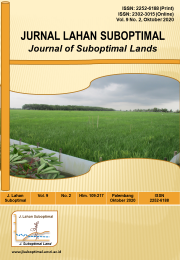Optimization of Palm Oil Cultivation in Ultisol Land Through the Planting of Mucuna bracteata
DOI:
https://doi.org/10.33230/JLSO.9.2.2020.494Keywords:
erosion, fertilizer, soil cover, surface run offAbstract
Saragi H, Asriani E, Putri K. 2020. Optimization of palm oil cultivation in ultisol land through the planting of mucuna bracteata. Jurnal Lahan Suboptimal : Journal of Suboptimal Lands 9(2): 160-166.
The utilization of ground cover crops is one way to optimize oil palm cultivation. The purpose of this study was to determine the ability of the land cover to hold soil, hold fertilizer, and cover land growth on open and closed land. This study was conducted from July to August 2016 in PT Rebinmas Jaya, Belitung Regency, Bangka Belitung Islands Province. The method used is the method of observation carried heavy eroded soil and fertilizer leaching rate in the area planted and unplanted Mucuna bracteata and growth of ground cover in open and enclosed land. Anova test results showed all treatments were not significantly different from the weight of eroded soil and the rate of washing of fertilizer. Mucuna bracteata grows faster in open areas. Ground cover (Mucuna bracteata) can hold soil and fertilizer, M. bracteata is planted when oil palms is young or immature.
Downloads
Published
How to Cite
Issue
Section
License
Copyright (c) 2020 Herliana Saragi, Euis Asriani, Kartika Putri

This work is licensed under a Creative Commons Attribution-NonCommercial-ShareAlike 4.0 International License.













